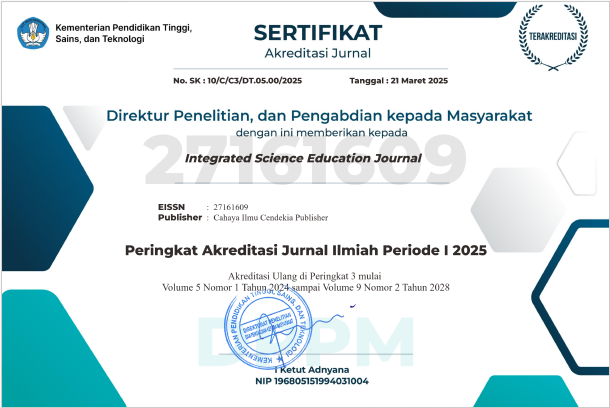Implementation Analysis of Problem Based Learning Modeland the Correlation of the Creative Attitude of Class X Students on Chemical Bonding Materials
Abstract
Purpose of the study: This study aims to analyze the Implementation of the Problem Based Learning Model and its Correlation to the Creative Attitudes of Students in the Chemical Bonding Material for Class X SMA Negeri 5 Tanjung Jabung Timur.
Methodology: This research is a correlational descriptive with a purposive sampling technique. Data were collected using an instrument in the form of an observation sheet on the implementation of PBL mode and students' creative attitudes. The data was obtained in the form of quantitative data and qualitative data. Quantitative data were tested by regression to see the significance of the effect of implementing the problem-based learning model on students' creative attitudes. While the qualitative data obtained were analyzed using the analysis of Miles and Huberman.
Main Findings: The analysis results show that the implementation of the PBL model by teachers and students is included in the good category. The correlation coefficient obtained is 0.707, meaning that the relationship between the implementation of the PBL model and students' creative attitudes has a strong relationship level. The results of the t-test indicate that tcount > ttable is 5,295>2,048, which means that the implementation of the PBL model affects students' creative attitudes.
Novelty/Originality of this study: Thus, it can be concluded that there is a relationship between the implementation of the PBL model and the creative attitude of class X students of SMA Negeri 5 Tanjung Jabung Timur on chemical bonding.
References
N. N. Simamora, W. A. Putri, M. Iqbal, A. Ramadhanti, and E. F. S. Rini, “Description of Student Discipline Attitudes at SMP Negeri 16 Jambi City,” Lensa J. Kependidikan Fis., vol. 8, no. 2, p. 76, 2020, doi: 10.33394/j-lkf.v8i2.3175.
W. A. Putri, R. Fitrini, E. F. S. Rini, F. T. Aldila, and T. Ratnawati, “Pengaruh Motivasi Terhadap Hasil Belajar Siswa IPA di SMAN 6 Muaro Jambi,” SAP (Susunan Artik. Pendidikan), vol. 5, no. 3, 2021.
E. F. Setiya Rini, R. Fitriani, W. A. Putri, A. A. B. Ginting, and M. M. Matondang, “Analisis Kerja Keras dalam Mata Pelajaran Fisika di SMAN 1 Kota Jambi,” SAP (Susunan Artik. Pendidikan), vol. 5, no. 3, pp. 221–226, 2021, doi: http://dx.doi.org/10.30998/sap.v5i3.7764.
E. F. Setiya Rini, D. Darmaji, and D. A. Kurniawan, “Identifikasi Kegiatan Praktikum dalam Meningkatkan Keterampilan Proses Sains di SMPN Se-Kecamatan Bajubang,” Edukatif J. Ilmu Pendidik., vol. 4, no. 2, pp. 2476–2481, 2022.
M. M. Matondang, E. F. Setiya Rini, N. D. Putri, and F. Yolvianysah, “Uji Perbandingan Motivasi Belaajar Siswa Kelas XI MIPA 2 dan XII MIPA 2 di SMA Negeri 1 Muaro Jambi,” J. Sains dan Pendidik. Fis., vol. 16, no. 03, pp. 218–227, 2021, doi: https://doi.org/10.35580/jspf.v16i3.15553.
E. F. Setiya Rini, “Pengaruh Kemandirian terhadap Prestasi Belajar Siswa Kelas XI di SMA Negeri 11 Kota Jambi,” J. Pendidik. Fis. dan Teknol., vol. 6, no. 2, pp. 256–263, 2020.
R. S. Dewi, Haryono, and S. B. Utomo, “Upaya Peningkatan Interaksi Sosial dan Prestasi Belajar Siswa dengan Problem Based Learning pada Pembelajaran Kimia Pokok Bahasan Sistem Koloid di SMA N 5 Surakarta Tahun Pelajaran 2011/2012,” J. Pendidik. Kim., vol. 2, no. 1, pp. 15–20, 2013.
E. Eliyarti and C. Rahayu, “Deskripsi Efektivitas Kegiatan Praktikum Dalam Perkuliahan Kimia Dasar Mahasiswa Teknik,” Edu Sains J. Pendidik. Sains Mat., vol. 7, no. 2, pp. 51–60, 2019, doi: 10.23971/eds.v7i2.1476.
A. A. S. N. A. Pucangan, S. K. Handayanto, and H. Wisodo, “Pengaruh Scaffolding Konseptual dalam Problem Based Learning terhadap Kemampuan Pemecahan Masalah,” J. Pendidik. Teor. Penelitian, dan Pengemb., vol. 3, no. 10, pp. 1314–1318, 2018.
D. Darmaji, D. A. Kurniawan, A. Astalini, and E. F. S. Rini, “Science Processing Skill and Critical Thinking: Reviewed Based on the Gender,” Juenal Pendidik. Indones., vol. 11, no. 1, 2022, doi: http://dx.doi.org/10.23887/jpi-undiksha.v11i1.35116.
E. W. Laksono, Suyanta, and I. Rizky, “Problem-based learning implementation to develop critical thinking and science process skills of madrasah Aliyah students in yogyakarta,” J. Phys. Conf. Ser., vol. 1097, no. 1, 2018, doi: 10.1088/1742-6596/1097/1/012059.
A. Shishigu, A. Hailu, and Z. Anibo, “Problem-based Learning and Conceptual Understanding of College Female Students in Physics,” Eurasia J. Math. Sci. Technol. Educ., vol. 14, no. 1, pp. 145–154, 2018, doi: 10.12973/ejmste/78035.
D. Chen, R. Fitriani, S. Maryani, E. F. Setiya Rini, W. A. Putri, and A. Ramadhanti, “Deskripsi Keterampilan Proses Sains Dasar Siswa Kelas VIII Pada Materi Cermin Cekung,” PENDIPA J. Sci. Educ., vol. 5, no. 1, pp. 50–55, 2021, doi: 10.33369/pendipa.5.1.50-55.
Kholilah, A. Ramadhanti, R. Fitriani, E. Febri, and M. R. Pratiwi, “Hubungan Kerja Keras Dan Hasil Belajar Fisika Di Sma Negeri 1 Kota Jambi,” J. Sci. Educ. Pract., vol. 4, pp. 41–48, 2020
A. Ramadhanti, K. Kholilah, R. Fitriani, E. F. S. Rini, and M. R. Pratiwi, “Hubungan Motivasi Terhadap Hasil Belajar Fisika Kelas X MIPA di SMAN 1 Kota Jambi,” J. Eval. Educ., vol. 3, no. 2, pp. 60–65, 2022.
N. W. Idris, Usman, and Subaer, “Pengaruh Model Pembelajaran Berbasis Masalah Terhadap Kemampuan Berpikir Kritis Peserta Didik,” J. Sains dan Pendidik. Fis., vol. 16, no. 1, pp. 39–50, Aug. 2020.
Ricky Purnama Wirayuda Rimi Wandai and A. A. B. Ginting, “Hubungan Sikap Siswa Terhadap Hasil Pembelajaran Fisika SMA N 1 Kota Sungai Penuh,” Integr. Sci. Educ. J., vol. 3, no. 1, 2022.
R. P. D. D. Wirayuda and D. A. Kurniawan, “Identification of Science Process Skills and Students’ Creative Thinking Ability In Science Lessons,” Attract. Innov. Educ. J., vol. 4, no. 1, 2022.
D. Darmaji, A. Astalini, D. A. Kurniawan, and F. T. Aldila, “Gender and Perception: Implementation of Web-based Character Assessment in Science Learning,” J. Educ. Res. Eval., vol. 6, no. 1, 2022.
F. T. Aldila, M. M. Matondang, and L. Wicaksono, “Identifikasi Minat Belajar Siswa Terhadap Mata Pelajaran Fisika Di Sman 1 Muaro Jambi,” J. Sci. Educ. Pract., vol. 4, no. 2, 2020.
F. Yolvianysah, Suryanti, E. F. Setiya Rini, S. Wahyuni, and M. M. Matondang, “Hubungan Minat Belajar Siswa Terhadap Hasil Belajar Fisika di SMAN 3 Muaro Jambi,” Tunjuk Ajar J. Penelit. Ilmu Pendidik., vol. 4, no. 1, 2021.
Sugiyono, Metode Penelitian dan Pengembangan. Bandung: Alfabeta, 2015.
Sugiyono, Metode Penelitian Kuantitatif Kualitatif dan R & D. Bandung: Alfabeta, 2013.
Fatonah, U., Wirayuda, R. P., Wibisono, G., & Sakahuni, S. (2020). Analisis Minat Belajar Kelas Xi Sma Negeri 1 Sungai Penuh Pada Pembelajaran Fisika. Jurnal Sains dan Pendidikan Fisika, 16(2), 145-152.
Copyright (c) 2022 Siti Nurjannah

This work is licensed under a Creative Commons Attribution-NonCommercial 4.0 International License.
Authors who publish with this journal agree to the following terms:
- Authors retain copyright and acknowledge that the Integrated Science Education Journal is the first publisher licensed under a Creative Commons Attribution 4.0 International License.
- Authors are able to enter into separate, additional contractual arrangements for the non-exclusive distribution of the journal's published version of the work (e.g., post it to an institutional repository or publish it in a book), with an acknowledgment of its initial publication in this journal.
- Authors are permitted and encouraged to post their work online (e.g., in institutional repositories or on their website) prior to and during the submission process, as it can lead to productive exchanges and earlier and greater citation of published work.







.png)
.png)






